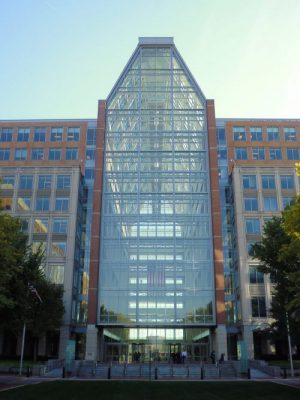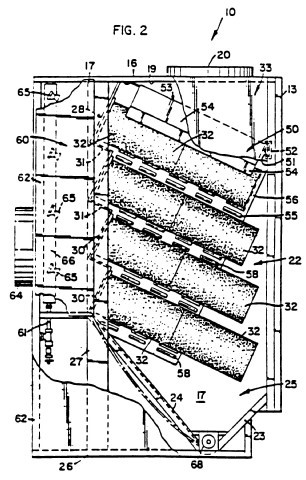2018年2月12日
著者:小野 康英(米国特許弁護士)

著者撮影
前回、米国特許商標庁(USPTO: United States Patent and Trademark Office)が編纂し発行する米国特許審査基準(MPEP: Manual of Patent Examining Procedure)は、USPTOに対する特許出願手続の実務において有益ではあるものの、法規範性を有さないため、究極的には、特許出願手続の法的根拠は、制定法及び判例に求める必要があること、及び、特に、実体的事項に影響を及ぼし得る事項について、判例を引用せず、USPTO審決例のみを引用し、又は、それすらも引用せずに制定法の解釈をしているMPEPの記載事項については注意が必要であることにつき注意喚起した。
今回は、この点に関連して、USPTOが長年にわたり運用してきた制定法の解釈を裁判所が否定した事件を紹介する(Donaldson事件)。
In re Donaldson, 16 F.3d 1189 (Fed. Cir. 1994) (en banc)
1.背景
(1)35 U.S.C. 112 (f)の沿革
構造、材料又は行為を規定する代わりに、特定の機能を実行する手段又は工程の形で表現された構成要素を含むクレームは、機能表現クレーム(MPF claim: Means-Plus-Function Claim)として、米国特許実務で多用される。
米国最高裁(Supreme Court of the United States)は、過去、Halliburton事件において、クレームの構成要素に機能表現を使用すること自体がクレームを不明確にする、すなわち、機能表現クレームは、常に、無効)と判示した。
Halliburton Oil Well Cementing Co. v. Walker, 329 U.S. 1 (1946)
Neither in the specification, the drawing, nor in the claims here under consideration, was there any indication that the patentee contemplated any specific structural alternative for the acoustical resonator or for the resonator's relationship to the other parts of the machine. ... [T]he broadness, ambiguity, and overhanging threat of the functional claim of Walker become apparent. ... The Halliburton device, alleged to infringe, employs an electric filter for this purpose. In this age of technological development there may be many other devices beyond our present information or indeed our imagination which will perform that function and yet fit these claims. And unless frightened from the course of experimentation by broad functional claims like these, inventive genius may evolve many more devices to accomplish the same purpose. ... Yet if Walker's blanket claims be valid, no device to clarify echo waves, now known or hereafter invented, whether the device be an actual equivalent of Walker's ingredient or not, could be used in a combination such as this, during the life of Walker's patent. (emphases added)
米国議会は、これに対して、1952年の米国特許法の全面改正時、35 U.S.C. 112 ¶ 3を新設し、Halliburtonを立法的に覆した。なお、本規定の条文番号は、その後、112 ¶ 6となり、さらにその後、リーヒ・スミス米国発明法(Leahy-Smith America Invents Act, Public Law 112-29, 125 Stat. 284 (Sept.16, 2011))により現行米国特許法における本規定の条文番号は112(f)となった。
112(f)は以下のとおり規定されている。
35 U.S.C. 112 Specification.
(f) ELEMENT IN CLAIM FOR A COMBINATION.—An element in a claim for a combination may be expressed as a means or step for performing a specified function without the recital of structure, material, or acts in support thereof, and such claim shall be construed to cover the corresponding structure, material, or acts described in the specification and equivalents thereof. (emphases added)【参考訳】
米国特許法第112条 明細書
(f) 組合せに係るクレームの構成要素―組合せに係るクレームの構成要素は、その構造、材料又は行為を規定することなく、特定の機能を実行する手段又は工程の形で表現できる。そのクレームは、明細書に記載された対応する構造、材料又は行為、及びその均等物を権利範囲とするように解釈される。(強調は筆者)
本規定の第1文は、Halliburtonを立法的に覆し、組合せに係るクレームの構成要素について機能表現の使用を容認する。一方、第2文は、Halliburtonが指摘した機能表現の「機能的クレームの広さ、曖昧さ、及び、差し迫った脅威(broadness, ambiguity, and overhanging threat of the functional claim)」を除去すべく、その権利範囲を「明細書に記載された対応する構造、材料又は行為、及びその均等物」に制限することで、機能表現の使用及び権利範囲の間の均衡を図っている。
112(f)はその適用場面につき、審査時及び裁判時の区別をしていない。しかし、USPTOは、長年にわたり、112(f)は裁判時にのみ適用される、すなわち、審査時、クレームには、明細書と矛盾しない範囲で、最広義の合理的解釈(BRI: Broadest Reasonable Interpretation)(注1)が与えられるので112(f)は適用されないと解し、審査時には、「機能的に表現された構成要素と同一の機能を奏する先行技術は、それが明細書に記載された対応構造等又はその均等物かどうかを問わず、その構成要素を開示する」という運用を続けてきた。この解釈に従えば、たとえば、クレームが一構成要素として"means for fixing an element A to an element B"を規定し、かつ、明細書が、これに対応する構造として、"nail"を開示する場合、審査官は、"glue"を開示する先行技術文献はこの"means for fixing ..."を開示すると主張できることになる。
なお、このUSPTOの解釈は、USPTOの高官として現行米国特許法(35. U.S.C.)の草案作成に携わったとされる人物の一人であるPasquale J. Federico氏の見解と符合すると思われる(注2)。
この背景の下、USPTOでの審査における112(f)の適否が真正面から争われたのがDonaldson事件である。本事件は、1952年に本規定が新設されて以降初の連邦巡回区控訴裁大法廷判決(Federal Circuit en banc decision)(注3)である。
以下、本稿において、本規定の引用にあたっては、事件当時に適用されていた法律に基づき、112 ¶6との表記を用いる。
(2)事件の経緯
Schuler出願は、空気清浄フィルターに関する。本事件の論点は、Schuler出願のClaim 1がSwift特許(先行技術)に基づき拒絶されるかどうかであった。
Claim 1の一構成要素:"means [24], responsive to pressure increases in said chamber [22] caused by said cleaning means [65], for moving particulate matter in a downward direction"(前記清掃手段[65]により生じる、前記チャンバ[22]内の圧力の上昇に応じて、粒状物質を下方向に移動させる手段[24])
明細書に開示の構造(対応構造):"flexible-wall, diaphragm-like structure, such that the hopper is made up of at least one flexible wall which expands outward upon pressure increases, thus causing caked-on dust to break loose from the wall of the hopper and fall towards the auger screw due to gravity"(圧力上昇に応じて形状変化する柔軟なホッパー)

Swift特許に開示の構造(Swiftホッパー):"[Hopper that is] rigid and non-responsive to any pressure increases within the collector"(圧力上昇に応じて形状変化しない堅固なホッパー)
明細書の対応構造及びSwift特許に開示の構造の間には明確な相違があったが、審査官及び審判官合議体は、いずれも、"means [24] ... for moving"について112 ¶ 6を適用せず、"means [24] ... for moving"及びSwiftホッパーは、「チャンバ内の圧力の上昇に応じて粒状物質を下方向に移動させる」点で機能的に一致するので、両者の間に相違点はないとして、Swift特許は"means [24] ... for moving"を開示するとした。審査官及び審判官合議体は、いずれも、この事実認定に基づき、Claim 1はSwift特許に基づき自明であるとして、Claim 1を拒絶した。
2.連邦巡回区控訴裁判決
(1)結論
拒絶維持審決を破棄、差戻し。
(2)法廷意見の概要(起草者:Rich判事)
112 ¶ 6の文言を読む限り、同項の適用にあたり、審査時及び裁判時の取扱いを区別すべき理由は見当たらない。よって、USPTOでの特許性並びに裁判所での侵害論及び特許有効性のいずれの判断においても、112 ¶ 6が適用される。
USPTOは、審査時に112 ¶ 6を適用しないとする長年の審査慣行の事実が尊重されるべきと主張するが、その事実をもって制定法の誤った解釈の継続使用を正当化することはできない。
BRI基準との関係については、112 ¶ 6が許す範囲においてBRI基準を適用するのであるから、BRI基準及び112 ¶ 6は矛盾しない。よって、USPTOは、特許性判断において、BRI基準及び112 ¶ 6の矛盾を理由に明細書の対応構造を無視することは許されない。
本件において、112 ¶ 6に基づけば、"means [24] ... for moving"はSchulerの対応構造(柔軟なホッパー)と解釈される。これとSwiftホッパー(堅固なホッパー)とを比較すると両者は構造的に相違する。
以上より、両者が構造的に同じであることを前提として、Claim 1をSwift特許に基づき自明であると判断したことは誤りである。
3.コメント
(1)MPEPの改定
USPTOは、Donaldson (Fed. Cir. 1994) (en banc)を受けて、MPEPを改定した。具体的には、MPEP第6版第1改定(1995年9月)において、以下の記述が追加された。
MPEP (Sixth Edition, Revision 1, September 1995), 2181 Identifying a 35 U.S.C.112, Sixth Paragraph Limitation [R-1]
When making a determination of patentability under 35 U.S.C. 102 or 103, past practice was to interpret a "means or step plus function" limitation by giving it the "broadest reasonable interpretation." Under the PTO's long-standing practice this meant interpreting such a limitation as reading on any prior art means or step which performed the function specified in the claim without regard for whether the prior art means or step was equivalent to the corresponding structure, material or acts described in the specification. However, in Donaldson the Federal Circuit stated that:Per our holding, the "broadest reasonable interpretation" that an examiner may give means-plus-function language is that statutorily mandated in paragraph six. Accordingly, the PTO may not disregard the structure disclosed in the specification corresponding to such language when rendering a patentability determination. 29 USPQ2d at 1850.
Thus, examiners must interpret a 35 U.S.C. 112, sixth paragraph "means or step plus function" limitation in a claim as limited to the corresponding structure, materials or acts described in the specification and equivalents thereof in accordance with the following guidelines. (emphases added)
以上の記載は、判例(Donaldsonルール)だけでなく、判例に否定されたUSPTO自身の解釈を併記する点で異例である。
これに対し、現行のMPEP第9版第07.2015改定(2015年11月)は、後者の記載を削除し、代わりに、MPEPに法規範性のないことを念押しする記載を追加している。
MPEP (Ninth Edition, Revision 07.2015, Last Revised November 2015), 2181 Identifying and Interpreting a 35 U.S.C. 112(f) or Pre-AIA 35 U.S.C. 112, Sixth Paragraph Limitation [R-07.2015]
This section sets forth guidelines for the examination of 35 U.S.C. 112(f) or pre-AIA 35 U.S.C. 112, sixth paragraph, “means or step plus function” limitations in a claim. These guidelines are based on the Office’s current understanding of the law and are believed to be fully consistent with binding precedent of the Supreme Court, the Federal Circuit and the Federal Circuit’s predecessor courts. These guidelines do not constitute substantive rulemaking and hence do not have the force and effect of law.The Court of Appeals for the Federal Circuit, in its en banc decision In re Donaldson Co., 16 F.3d 1189, 1194, 29 USPQ2d 1845, 1850 (Fed. Cir. 1994), held that a “means-or-step-plus-function” limitation should be interpreted as follows:
Per our holding, the "broadest reasonable interpretation" that an examiner may give means-plus-function language is that statutorily mandated in paragraph six. Accordingly, the PTO may not disregard the structure disclosed in the specification corresponding to such language when rendering a patentability determination.
Therefore, the broadest reasonable interpretation of a claim limitation that invokes 35 U.S.C. 112(f) or pre-AIA 35 U.S.C. 112, sixth paragraph, is the structure, material or act described in the specification as performing the entire claimed function and equivalents to the disclosed structure, material or act. As a result, section 112(f) or pre-AIA section 112, sixth paragraph, limitations will, in some cases, be afforded a more narrow interpretation than a limitation that is not crafted in “means plus function” format. (emphases added)
MPEPが法規範性を有さないことはその前文で既に述べられている。それにもかかわらず、本項に限り、さらにその点が念押しされている点も異例である。この記載から、USPTOが機能表現クレームの解釈について慎重な姿勢を貫いていることがうかがえる。
MPEP (Ninth Edition, Revision 07.2015, Last Revised November 2015), Foreword
The Manual does not have the force of law or the force of the rules in Title 37 of the Code of Federal Regulations. (emphasis added)
(2)日本国特許法における機能表現クレームの取扱い
日本国特許法(昭和34年法律第121号)には、米国特許法における112(f)に対応する規定は存在しない。日本国特許庁が編纂する特許・実用新案審査基準は、機能表現クレーム(を含む機能表現全般)について、Donaldson (Fed. Cir. 1994) (en banc)前のUSPTOの解釈に近似する解釈を提示する(注4)。日本の特許出願の審査はこの解釈に従い行われている。一方、日本法は先例拘束の原理(the doctrine of stare decisis)を採用しないので、裁判所においては、担当判事が、先例に必ずしもとらわれることなく、日本国憲法及び良心に従い(日本国憲法第76条参照)、事件ごとに、機能表現クレームの判断基準についての規範を定立し、結論を導いている。傾向としては、機能表現構成要素の機能を果たす明細書に開示された対応構造+αまでを権利範囲として認める裁判例が多いと思われる(注5)。
Donaldson (Fed. Cir. 1994) (en banc)は、機能表現クレームという実務上重要な法域について指針を示した初の連邦巡回区控訴裁大法廷判決という意義を有するが(注6)、それに加えて、判例に基づかないUSPTOの法解釈には注意が必要であることにつき注意喚起する事例としての意義をも有すると考えられる。
注釈
(注1)
Phillips v. AWH, 415 F.3d 1303 (Fed. Cir. 2005) (en banc)
The Patent and Trademark Office ... determines the scope of claims in patent applications not solely on the basis of the claim language, but upon giving claims their broadest reasonable construction "in light of the specification as it would be interpreted by one of ordinary skill in the art." (emphasis added)
BRI基準は、裁判時よりもクレームを広く(先行技術が含まれやすく、クレームが拒絶されやすく)解釈するという意味で、出願人に不利である。判例は、審査時におけるBRI基準の採用が正当化される根拠として、出願人による補正の機会の存在、並びに、公衆及び出願人の間の公平性を考慮した審査におけるクレーム範囲の適正化の要請を挙げている。
Cuozzo Speed Tech. v. Lee (as Under Secretary of Commerce for Intellectual Property and Director, Patent And Trademark Office), 579 U.S. ____ (2016)
In an initial examination of an application for a patent the examiner gives the claim its broadest reasonable construction. But if the patent examiner rejects the claim, then[] the applicant has a right to amend and resubmit the claim. And the examiner and applicant may repeat this process at least once more. This system—broad construction with a chance to amend—both protects the public from overly broad claims and gives the applicant a fair chance to draft a precise claim that will qualify for patent protection. (emphases added)
(注2)
Federico, Commentary on the New Patent Act, reprinted in 75 J. Pat. & Trademark Off. Soc'y 161 (1993).
The last paragraph of section 112 relating to so-called functional claims is new. ... It is unquestionable that some measure of greater liberality in the use of functional expressions in combination claims is authorized than had been permitted by some court decisions and that decisions such as that in Halliburton Oil Well Cementing Co. v. Walker, 67 S.Ct. 6, 329 U.S. 1, 91 L. Ed. 3 (1946), are modified or rendered obsolete, but the exact limits of the enlargement remain to be determined. ... The paragraph ends by stating that such a claim shall be construed to cover the corresponding structure, material, or acts described in the specification and equivalents thereof.[] This relates primarily to the construction of such claims for the purpose of determining when the claim is infringed (note the use of the word "cover"), and would not appear to have much, if any, applicability in determining the patentability of such claims over the prior art, that is, the Patent Office is not authorized to allow a claim which "reads on" the prior art. (emphasis added)
(注3)連邦巡回区控訴裁大法廷判決(Federal Circuit en banc decision)は連邦巡回区控訴裁の常勤判事全員で行う判決であり、その要件は、米国最高裁が公布する上訴手続に関する連邦規則(FRAP: Federal Rules of Appellate Procedure)35に規定されている。以下に引用するとおり、事件が例外的に重要な法的論点を含み、かつ、常勤判事の過半数が賛同する場合に、事件当時者の申立て(petition)又は判事の発意(sua sponte motion)により、その事件は大法廷の審理に付される。
FRAP 35. En Banc Determination
(a) When Hearing or Rehearing En Banc May Be Ordered. A majority of the circuit judges who are in regular active service and who are not disqualified may order that an appeal or other proceeding be heard or reheard by the court of appeals en banc. An en banc hearing or rehearing is not favored and ordinarily will not be ordered unless:(1) en banc consideration is necessary to secure or maintain uniformity of the court’s decisions; or
(2) the proceeding involves a question of exceptional importance.
なお、連邦巡回区控訴裁の常勤判事の定数は法律で12名と定められている(28 U.S.C. 44(a))。また、同裁判所の判事は、常勤(full time)及び非常勤(senior)の別を問わず、コロンビア特別区から50マイル(80キロメートル超)以内に居住することを義務付けられている(28 U.S.C. 44(c))。
(注4)
特許庁編「特許・実用新案審査基準」(2015年9月改定) 第Ⅱ部 第2章 新規性・進歩性 第2章 新規性・進歩性
1.5 新規性の判断の手法
1.5.2 特定の表現を有する請求項における発明の認定の具体的手法
(1) 作用、機能、性質又は特性(以下、「機能・特性等」という。)を用いて物を特定しようとする記載がある場合
①請求項中に機能・特性等を用いて物を特定しようとする記載がある場合には、1.5.1⑵にしたがって異なる意味内容と解すべき場合(注)を除き、原則として、その記載は、そのような機能・特性等を有するすべての物を意味していると解釈する。例えば、「熱を遮断する層を備えた壁材」は「断熱という作用ないしは機能を有する層」という「物」を備えた壁材と解する。
(注)例えば、「~の組成を有する耐熱性合金」という請求項について、明細書及び図面の記載並びに出願時の技術常識を考慮して請求項に係る発明を認定した結果、「耐熱性合金」との記載は「耐熱性を必要とする用途に用いる合金」の意味であると解すべき場合には、下記(2)の用途により物を特定しようとする記載がある場合の取扱いにしたがう。
②ただし、その機能・特性等が、その物が固有に有しているものである場合は、その記載は物を特定するのに役に立っておらず、その物自体を意味しているものと解する。…③また、出願時の技術常識を考慮すると、そのような機能・特性等を有するすべての物のうち特定の物を意味しているとは解釈すべきでない場合がある。
例えば「木製の第一部材と合成樹脂製の第二部材を固定する手段」という請求項の記載においては、「固定する手段」は、すべての固定手段のうち溶接等のような金属に使用される固定手段は意味していないことは明らかである。(2) 物の用途を用いてその物を特定しようとする記載(用途限定)がある場合
請求項中に、「~用」といった、物の用途を用いてその物を特定しようとする記載(用途限定)がある場合には、明細書及び図面の記載並びに出願時の技術常識をも考慮して、その用途限定が請求項に係る発明を特定するための事項としてどのような意味を有するかを把握する。(請求項に係る発明を特定するための事項としての意味が理解できない場合は、第36条第6項第2号違反となり得ることに留意する。)(強調は筆者)
(注5)以下に、微妙に異なるルールを提示する2つの裁判例の一部を引用する。本文で述べたとおり、日本法は先例拘束の原理(the doctrine of stare decisis)を採用しないので、日本国憲法及び良心に従い判決する限り、下級審裁判所間の法解釈の相違は法的には問題でない。ただし、当事者の事情と関係のない理由により減殺される予測可能性、別事件の当事者との間の公平等の観点からは、この状況が由々しき事態であることは否めない。
東京地裁平成10年(1998年)12月22日民事第46部判決(平成8年(ワ)第22124号、裁判長裁判官 三村量一)
…実用新案登録請求の範囲に記載された考案の構成が機能的、抽象的な表現で記載されている場合において、当該機能ないし作用効果を果たし得る構成であればすべてその技術的範囲に属すると解すると、明細書に開示されていない技術思想に属する構成までもが考案の技術的範囲に属することになり、出願人が考案した範囲を超えて実用新案による保護を与える結果となりかねないが、このような結果が生じることは、実用新案権に基づく考案者の独占権は当該考案を公衆に対して開示することの代償として与えられるという実用新案の理念に反することになる。したがって、実用新案登録請求の範囲[に記載された考案の構成が機能的、抽象的な表現]で記載されている場合には、その記載のみによって考案の技術的範囲を明らかにすることはできず、右記載に加えて明細書の考案の詳細な説明の記載を参酌し、そこに開示された具体的な構成に示されている技術思想にもとづいて当該考案の技術的範囲を確定すべきものと解するのが相当である。ただし、このことは、考案の技術的範囲を明細書に記載された具体的な実施例に限定するものでなく、実施例としては記載されていなくとも、明細書に開示された考案の記述に関する内容から当該考案の属する技術の分野における通常の知識を有する者(以下「当業者」という。)が実施し得る構成であれば、その技術的範囲に含まれるものと解すべきである。(強調は筆者)東京高裁平成15年(2003年)9月9日所第6民事部判決(平成14年(ネ)第3714号、裁判長裁判官 山下和明)
当裁判所は、構成要件D③につき、原判決のいうように本件明細書の発明の詳細な説明中の実施例に記載された「コイルスプリングによる付勢」に限られるわけではないものの、「コイルスプリングと均等(等価)な、摺動部材を前方に付勢する部材による付勢力の存在下において、空間部形成部材内のガス圧の低下を原因として摺動部材の位置が切り換えられる」と理解すべきであり、被告製品は、このような摺動部材を付勢する部材を有しないから、構成要件D③を充足しない、と判断する。控訴人の主張する方法のうち、板バネ、弾性ゴム材の付勢力を利用する方法は、実施例におけるコイルスプリングと均等(等価)な方法であると認められるから、本件発明の技術的範囲に含まれるというべきである。しかしながら、そのことから、控訴人が主張するその余のガス圧、ガスの流れ、吸引力などによって摺動部材の位置を切り換える方法までが、当然に、本件発明の技術的範囲に含まれることになるわけのものではない。これら本件明細書に明示されていない方法が本件発明の技術的範囲に含まれているというためには、本件明細書に接した当業者において、これらガス圧などにより摺動部材の位置を切換える方法が、明示の記載がなくともが記載されていると同じであると理解するようなものであることが必要であるというべきである。本件においては、これらの方法がそのようなものであることを認めるに足りる主張、立証はない。(強調は筆者)
(注6) 1952年に35 U.S.C. 112 ¶ 3(現112(f))が新設されて以降、112(f)の歴史は優に半世紀を超え、かつ、112(f)についての論点は多数存在するが、112(f)の解釈についての連邦巡回区控訴裁大法廷判決は、In re Donaldson, 16 F.3d 1189 (Fed. Cir. 1994) (en banc)及びWilliamson v. Citrix Online, LLC , 792 F.3d 1339 (Fed. Cir. 2015) (en banc in relevant part)の2つだけである。前者は、本文で紹介したとおり、112(f)の適用場面(審査/裁判)を論点とする。一方、後者は、112(f)の適否判断(適用/不適用)を論点とする。いずれも、機能表現クレームの基本判例として、実務上、理解しておくことが好ましい判例と考えられる。
Next>>第6回:米国特許法の基本~MPEPの法規範性(その3)~
Previous<<第4回:米国特許法の基本~MPEPの法規範性~
